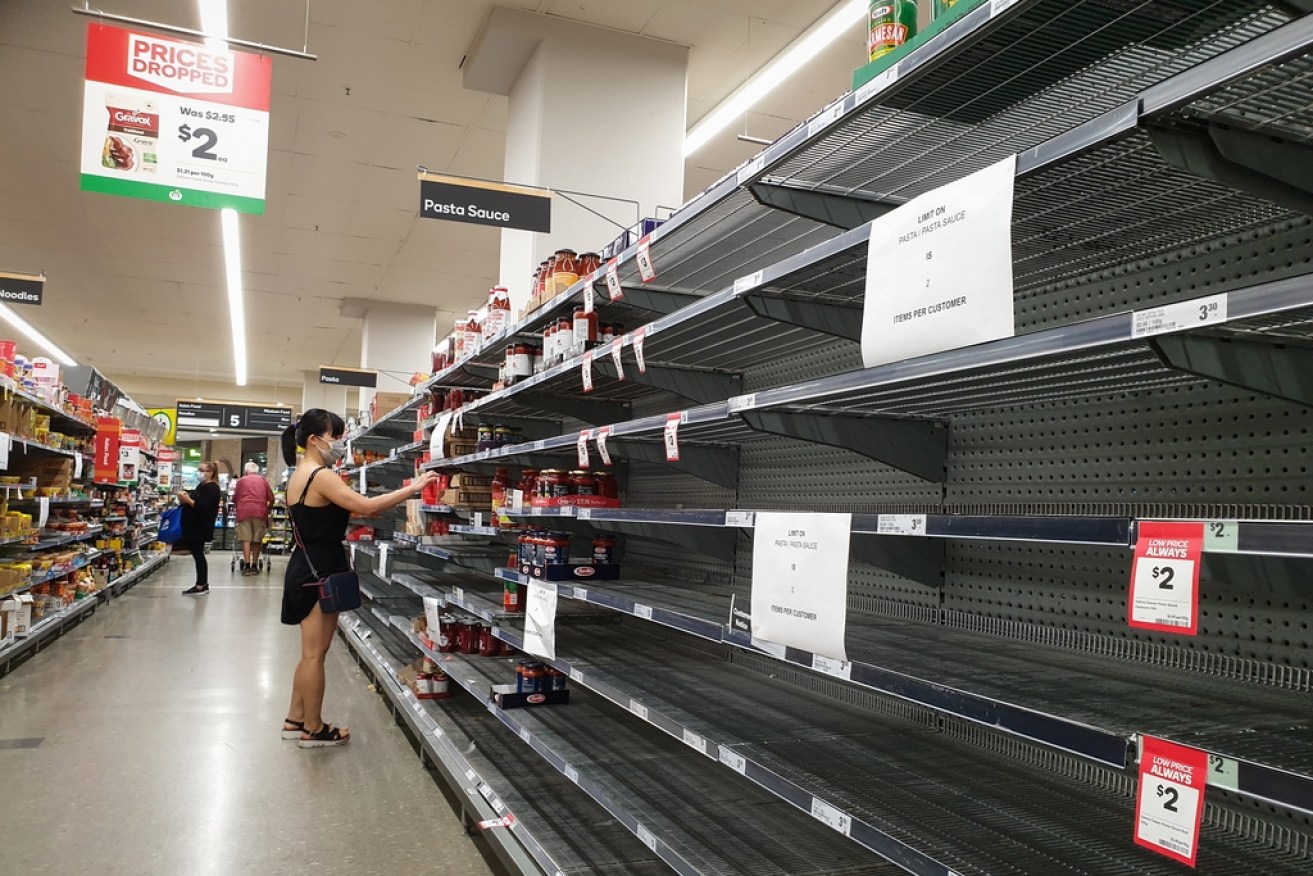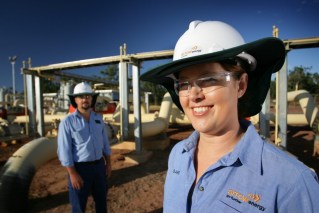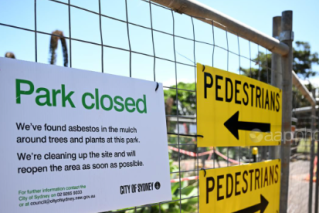We’ve avoided starvation for now, so let’s not make a meal of it
Little wonder shoppers are propelled into the occasional fit of panic buying – the rural back yard in which their food is grown has been under almost constant attack since before last Christmas, gradually fraying nerves and confidence. Brad Cooper reports


Has there been a time in generational memory when food supply chains have felt this vulnerable?
Decades of prolonged droughts, punctuated by searing heatwaves, fires and floods, all reminders that food production is still at the mercy of the natural world, despite all our technology and mechanisation.
Over time, it tugs at the moorings that anchor a population’s faith in its food supply.
The sheer size and scale of Australia’s agricultural complex, with a diverse portfolio of commodities grown over a wide geographical area, constitutes a genuinely titanic industry that is difficult to sink.
The Black Summer inferno of last year did its searing best, burning millions of hectares, decimating wildlife and razing properties, including some farming enterprises.
But it failed to cause widespread disruption to agricultural production as initially feared.
Although the enormous radius of the fires, coupled with their intensity and duration, cracked open a fissure in the mantle of security and safety Australians feel in their food supply channel.
And like hairline cracks on a windscreen exposed to heat, those fissures only widened further when coronavirus blasted into the headlines and into our hospital wards, unable to shield our supermarkets from the panic-buyers who scrambled for toilet paper, pasta, mince and tinned vegetables.
No wonder it felt like order was coming apart at the seams.
Yet, as InQueensland was early to highlight, the ability to produce enough food for our roughly 25.5 million residents, plus have the bulk left over for export, was never in question, even amid a raging pandemic.
The relative remoteness of farms, generally outside heavily populated areas, can mean negative health consequences for those living and working in isolated parts of the country.
But in the new era of physical distancing, this remoteness, something of a rural bubble, proved to be farming’s strongest natural asset.
The bigger danger was not to farm production per se, but the risks lurking in the nation’s supply chain network, with the potential to close down processing plants, disrupt transport operations and restrict the free movement of labour, resources and freight due to border restrictions.
Competent management of coronavirus cases in Australia and especially in Queensland, at least by some of the appallingly low benchmarks set overseas, mean those supply chains have been spared a lot of the strain that was threatened in the pandemic’s early stages – even if disruptions to overseas airfreight and China’s trade attacks, apparently in retaliation for Australia backing a probe into the origins of coronavirus, continue to prove troubling.
Perhaps the ongoing shortage of farm labour, caused by the dwindling supply of traditional overseas workers who have been limited by bans on international travel, has provided a glimpse of the chaos that might have ensued had the health response gone completely awry.
Even now, with sweeteners and subsidies provided by government to attract more Australians into farm work, plus legislative changes allowing easier deployment of Pacific Island workers, farm groups say they remain well short of what is required to harvest this season’s summer crops, with horticulture commodities hit hardest.
Amid the criticisms of the farm sector being an exploitative employer of foreign workers, InQueensland put its boots on the ground and its shoulder to the wheel to experience farm work first hand.
Flying invader lands
While threats to human health have dominated headlines this year, InQueensland was calling out serious exotic pest threats to our farm sector and natural flora and fauna, exposing lapses in our biosecurity shield that gave African swine fever a chance of opening the door to Queensland and allowed the entry of a Central American moth with a voracious appetite for crops.
While on our doorstep in PNG, African swine fever has been kept at bay for now, sparing our pork industry, but the fall armyworm has continued its inexorable march across the country since entering far north Queensland In January.
And it looks like the pest is here to stay, forcing federal regulators to issue fast-tracked control permits to farmers under siege from the foreign incursion.
While the permits increase the arsenal available to farmers to bring the pest to heel, industry group Grain Growers Australia has indicated the costs to agriculture go well beyond the dollars farmers will have to spend on chemicals.
A spokesman told InQueensland that depending on the depth of the infestation, farmers could be paying anywhere from $15 to $135 per hectare to treat the exotic moth.
Fall armyworm, which is actually a flying moth belying its name, has now been detected across large swathes of Queensland cropping country and interstate, including Moree, Narrabri and Wee Waa in NSW, Darwin, Katherine and the Douglas Daly regions of the Northern Territory and Western Australia in Kununurra, Ord Valley, Broome and Carnarvon.
The Queensland Government may have kept a lid on coronavirus, at least for now, but the puncture in its farm biosecurity shield, so critical for the nation’s overall agricultural health, due to the fact most of our pests and diseases enter from the north, has unleashed a truly hostile invader that will be costly to repel.
The possible damage yet to come is anyone’s guess.
The federal government regulator, the Australian Pesticides and Veterinary Medicine Authority (APVMA), is continuing to investigate further chemicals that will be effective against the pest as its targets widen across the country.
Grain Growers Australia believes costs to the industry will be substantial but difficult to calculate as the incursion continues to evolve.
“The costs relating to fall armyworm are threefold – yield losses and quality downgrading, management costs, including pesticides and application, and impacts on trade and export through restrictions or biosecurity measures,” the spokesman said.
“Fall armyworm is yet another challenge that our growers need to manage along with other challenges like recovering from the long-standing drought, which is still crippling in some parts of Australia.”
Farmers confident
Despite enduring a year that focused people’s attention on the business of growing food under the weight of seemingly relentless adversity from the climate, 2020 is ending with Queensland’s farmers feeling more optimistic about the future.
The latest quarterly rural confidence survey from specialist agriculture financial house, Rabobank, shows buoyancy across the state’s farming sectors, with 37 per cent of Queensland producers now expecting agricultural economic conditions to improve over the coming year – up from 23 per cent last quarter.
Cotton and grain growers show the sharpest rise in optimism, largely due to confidence in seasonal conditions and improved commodity prices.
The results have come as no surprise to Rabobank’s Queensland manager, Trent McIndoe, who has cited strong commodity prices, reasonable rain and low interest rates behind the confidence revival.
“Cattle producers continue to enjoy a strong market, harvest is done and dusted, the sugar cane crush continues uninterrupted, cotton and summer crops are in the ground and confidence is up across all sectors,” he said.
On the back of the first significant southern Queensland harvest in four years, McIndoe said there was a definite – albeit cautious – spring in the step of many grain growers across the state, with more than half (52 per cent) expecting conditions to improve in the coming 12 months, up from just 17 per cent last quarter.
“Prices for grain have declined from their peaks but remain strong compared with the 2016-17 record east coast harvest,” he said.
“Queenslanders have enjoyed a generally uninterrupted harvest, with yields and quality mixed, but overall better than expected.”
Queensland cotton growers are also enjoying a surge in confidence, with half (51 per cent) expecting conditions to improve, up from 18 per cent just three months ago.
Record prices and favourable seasonal conditions and outlook continue to buoy Queensland cattle producers, with 39 per cent now expecting conditions to improve (up from 27 per cent in the September quarter) and almost half (48 per cent) expecting little change to current conditions.
“Cattle sales have remained strong across the state, and Queensland’s spring bull sales were well-contested, continuing to break records,” McIndoe said.
Queensland sugar producers were also particularly upbeat about their future prospects, with more producers now expecting conditions to improve than worsen.
The survey results have emerged as Australia’s national agricultural economic forecaster, ABARES, tipped a seven per cent rise in the gross value of farm production to $65 billion in 2020-21.
Federal Agriculture Minister David Littleproud, whose electorate of Maranoa takes in a large portion of the state’s western country, said the forecast showed agriculture was “leading the way” in the nation’s post-Covid economic recovery.
“This is an outstanding result for the farming sector that has helped stay on an even keel despite all the challenges 2020 has thrown at us,” Littleproud said.
“Australians should be justly proud of what farming has achieved this year. Now more than ever we know the importance of the agriculture sector to our economy.”
Despite the positive signals, Littleproud said trade tensions with China and farm workforce shortages would prove ongoing challenges for the industry to manage.
“I am particularly concerned at the potential impacts of China’s decisions to impose anti-dumping and countervailing duties on barley and the recent impost of provisional anti-dumping duties on Australian wine,” he said.
“But I am buoyed by this latest forecast.”
While farmers pin their hopes on a wet summer materialising at some point after blistering heatwave conditions this month, McIndoe has tempered enthusiasm with descriptions of Queensland’s cropping districts as a “mixed bag”.
“Drought is continuing in some areas of the state, with a number of failed crops in the southern district, however the turn in the season and positive outlook has certainly given farmers the confidence that it can, and will, rain again,” he said.
“Queensland has enjoyed its first real start in three or four years, and while there is an exciting summer planting profile, in-crop rain over the coming months will determine the crop – hopefully La Nina is on its way to really shoring up the summer season.”
Queensland Agriculture Minister Mark Furner said it was great to see confidence following the state’s successful COVID-19 health response and some encouraging signs when it comes to rainfall.
“More than 67 per cent of the state remains drought declared, so we’re not taking anything for granted and we continue to stand shoulder to shoulder with Queensland farmers who are doing it tough,” he said.












